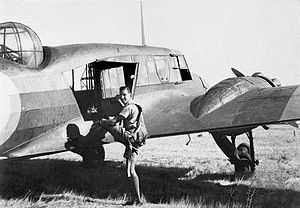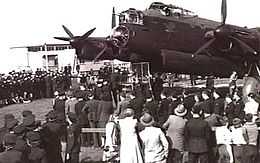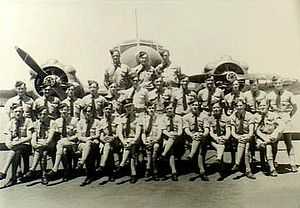No. 4 Service Flying Training School RAAF
| No. 4 Service Flying Training School RAAF | |
|---|---|
|
Advanced Training Squad of No. 4 Service Flying Training School in front of an Avro Anson, December 1942 | |
| Active | 1941–1945 |
| Allegiance |
|
| Branch |
|
| Role | Intermediate/advanced flying training |
| Garrison/HQ | RAAF Station Geraldton |
No. 4 Service Flying Training School (No. 4 SFTS) was a flying training school of the Royal Australian Air Force (RAAF) during World War II. It was formed in February 1941, and commenced flying the following month. Responsible for intermediate and advanced instruction of pilots under the Empire Air Training Scheme (EATS), the school was based at RAAF Station Geraldton, Western Australia, and operated Avro Anson aircraft. Two reserve squadrons were formed at the school in response to the outbreak of war in the Pacific, though they never saw action. Flying activity began to taper off towards the end of 1943, and the school was disbanded in May 1945, having graduated over 1,000 pilots.
History
RAAF aircrew training expanded dramatically following the outbreak of World War II, in response to Australia's participation in the Empire Air Training Scheme (EATS). The Air Force's pre-war flight training facility, No. 1 Flying Training School at RAAF Station Point Cook, Victoria, was supplanted in 1940–41 by twelve Elementary Flying Training Schools (EFTS), eight Service Flying Training Schools (SFTS), and Central Flying School (CFS).[1][2] While CFS turned out new flight instructors, the EFTS provided basic training to prospective pilots who, if successful, would go on to SFTS for further instruction that focussed on operational (or "service") flying.[1][3] The course at SFTS typically consisted of two streams, intermediate and advanced, and included such techniques as instrument flying, night flying, advanced aerobatics, formation flying, dive bombing, and aerial gunnery.[1][4] The total duration of training varied during the war as demand for aircrew rose and fell. Initially running for 16 weeks, the course was cut to 10 weeks (which included 75 hours flying time) in October 1940. A year later it was raised to 12 weeks (including 100 hours flying time), and again to 16 weeks two months later. It continued to increase after this, peaking at 28 weeks in June 1944.[4]

No. 4 Service Flying Training School (No. 4 SFTS) was formed at RAAF Station Geraldton, Western Australia, on 10 February 1941. Its inaugural commanding officer was Wing Commander P.G. Heffernan. Geraldton was a new air base, and its facilities were still under construction when the first course of flying training commenced on 10 March. A further challenge the school faced related to equipment. All its Avro Anson aircraft were transferred from other units that, according to the RAAF Historical Section, "happily disposed of their oldest air frames". Coupled with a shortage of the spare parts needed to keep such aircraft operational, the result was that flying hours remained low for some time.[5] No. 4 SFTS received its students from No. 9 Elementary Flying Training School at Cunderdin, Western Australia.[6][7] Approximately 60 entrants arrived every 28 days, of whom around 50 were expected to graduate. Discipline at the school was strict, the aim being to cut down on the accidents what were typical of service flying training establishments. In the event, No. 4 SFTS did not suffer a fatal flying accident until almost two years after it commenced operations.[5]

In November 1941, eight Ansons from No. 4 SFTS took part in the search for survivors from HMAS Sydney.[5][8] Following the outbreak of the Pacific War in December, the school's aircraft were classified as Second Line (Reserve) aircraft in the defence of Australia.[5][9] Nos. 68 and 69 Reserve Squadrons were formed at Geraldton, but they were only used for maritime search-and-rescue, and saw no action before their disbandment in February 1943.[5] By the end of the year, flying at No. 4 SFTS had begun to taper off, and it was reduced still further in 1944. The school began disbanding in January 1945, and the task was complete by May. It had graduated over 1,000 pilots—among them Dave Shannon, awarded the Distinguished Service Order for his part in the Dambuster raid by No. 617 Squadron RAF in May 1943—and established "an enviable safety record".[5][10] No. 87 Operational Base Unit (No. 87 OBU) was formed at Geraldton on 1 June 1945 to administer the base facilities following the disbandment of No. 4 SFTS. On 20 May 1946, No. 87 OBU was disbanded and re-formed as Care and Maintenance Unit Geraldton, which was itself disbanded on 5 September 1947.[11]
Notes
- ↑ 1.0 1.1 1.2 Stephens, The Royal Australian Air Force, pp. 67–70
- ↑ Gillison, Royal Australian Air Force 1939–1942, p. 111
- ↑ Gillison, Royal Australian Air Force 1939–1942, p. 97
- ↑ 4.0 4.1 Gillison, Royal Australian Air Force 1939–1942, p. 109
- ↑ 5.0 5.1 5.2 5.3 5.4 5.5 RAAF Historical Section, Units of the Royal Australian Air Force, Vol. 8, pp. 105–106
- ↑ "RAAF activities". The West Australian (Perth: National Library of Australia). 15 October 1940. p. 6. Retrieved 24 May 2012.
- ↑ "News and notes". The West Australian (Perth: National Library of Australia). 25 March 1941. p. 6. Retrieved 24 May 2012.
- ↑ Page, Wings of Destiny, p. 118
- ↑ Gillison, Royal Australian Air Force 1939–1942, pp. 234–238
- ↑ Australia Service Medal: Squadron Leader D J Shannon, 617 Squadron RAF at Australian War Memorial. Retrieved on 24 May 2012.
- ↑ RAAF Historical Section, Units of the Royal Australian Air Force, Vol. 1, p. 84
References
- Gillison, Douglas (1962). Australia in the War of 1939–1945: Series Three (Air) Volume I – Royal Australian Air Force 1939–1942. Canberra: Australian War Memorial. OCLC 2000369.
- Page, Charles (2008). Wings of Destiny. Dural, New South Wales: Rosenberg Publishers. ISBN 9781877058646.
- RAAF Historical Section (1995). Units of the Royal Australian Air Force: A Concise History. Volume 1: Introduction, Bases, Supporting Organisations. Canberra: Australian Government Publishing Service. ISBN 0-644-42792-2.
- RAAF Historical Section (1995). Units of the Royal Australian Air Force: A Concise History. Volume 8: Training Units. Canberra: Australian Government Publishing Service. ISBN 0-644-42800-7.
- Stephens, Alan (2006) [2001]. The Royal Australian Air Force: A History. London: Oxford University Press. ISBN 0-19-555541-4.
Further reading
- Jubbs, Leslie R. (2005). No. 4 Service Flying Training School. Kingsley, Western Australia: L.R. Jubbs with the assistance of the Department of Veterans' Affairs. OCLC 271610908.
